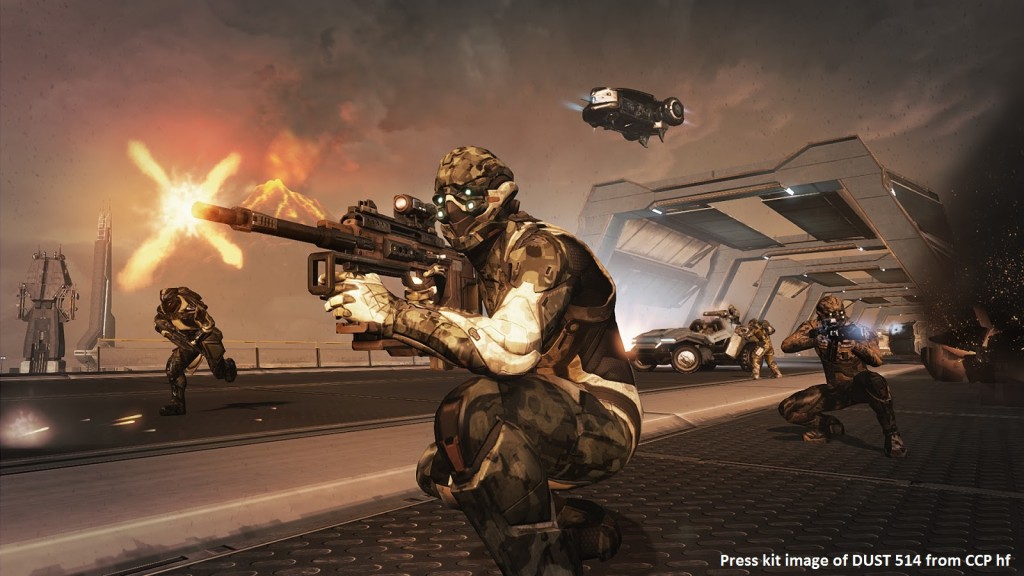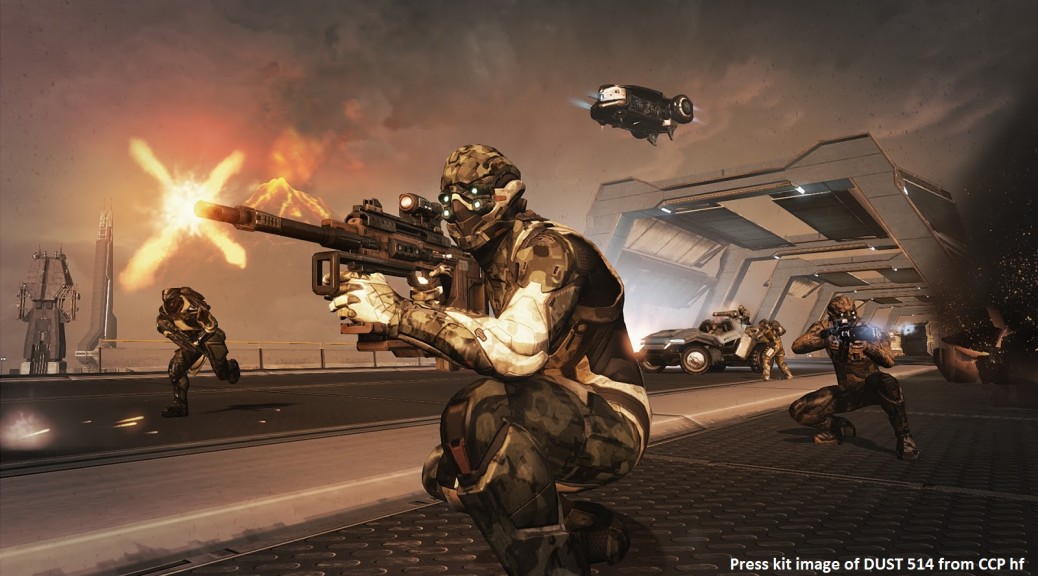DUST 514 should be boring.
I’ve finally managed to borrow a PS3 and get stuck into DUST for a while. As an EVE Online nut, I’ve been hoping to do this for quite some time. And also as an EVE Online nut, I’ve heard plenty about how it’s not really all that great a game.
It appears to have come a significant way since its release in terms of having bugs removed. I’ve still found a few glitches where the game can’t decide on your exact location, but they’re usually resolved once someone forcefully respawns you. There are also a few glitches with using a keyboard and mouse instead of the typical controller setup — sometimes the keys it tells you to use just don’t work, and sometimes it tells you to use a controller button instead. I’m using a keyboard-mouse because I’ve not been able to get used to aiming with the PS3 controller (the sensitivity always feels wrong to my XBOX-trained hands).

But chief among possible grievances is that the game types seem extremely limited. (I should say at the outset that I’ve not joined a major player-owned corporation, so there might be things I’m missing here.) There are three game types for regular matches: “Ambush”, which is your standard kill-everyone mode with a time limit and a ‘clone limit’ of 50; “Domination”, which is a standard King of the Hill mode and which has a ‘clone limit’ of 150; and “Skirmish”, which is a multiple hill variant of “Domination”. That’s it. The ‘clone limit’ mechanic (each time you respawn you start in a new clone of yourself — a technological link back to EVE that’s fictionalised in the novel EVE: Templar One if you’re interested) and the abstracted victory conditions add unpredictability to the end point of the match; the match ends either when your team’s out of clones or when you destroy the opposition’s Mobile Command Centre by maintaining control of an auto-firing cannon for longer than the other guys. And despite taking place on differing planets throughout the EVE game world, there are a fairly limited number of maps. Perhaps humans in the distant future take the term “parallel Earth” a little too literally and just terraform planets to look identical.
What soon becomes apparent is that DUST 514 relies not on variety but on unpredictability, setup, strategy and cooperation in equal parts to make gameplay interesting. In hindsight, and being an EVE Online nut, I should have expected this from CCP (who develop both DUST and EVE) because it’s rather similar to the EVE philosophy. Setting up a dropsuit fit is almost absurdly similar to fitting out a ship in EVE, even to the point of using many of the same fictional technologies. As an EVE nut it’s sort of comfortingly familiar, but I’m certain that non-EVE players would find the translation of EVE‘s steep technical learning curve into the FPS genre a bit odd.
As for cooperation, it apparently happens sometimes. There are up to 16 players per side, which is enough to pull off some expert manoeuvres if you’re more coordinated than the other guys. This happens, though most games seem to have one or two organised squads and a much larger crew of lone rangers. I’ve never heard any comms on the chat channel for the entire team, so I’m guessing the squads use their own comms channel. Good one, guys. While this makes strategising fairly challenging, there are enough support roles built into the game to make tacking yourself on to someone else’s strategy a moderately rewarding play style. You can be a medic if you want, reviving your incapacitated team mates to prevent using up valuable clones. If you’ve got the skills, you can be a heavy gunner, or drive or fly a vehicle. Haven’t played around with those myself, don’t have the skills. What I have been mucking around with is being a sniper.
I think the way DUST does sniping is the biggest surprise I’ve had from this game. I’m actually better at sniping in this game than at regular soldiering (at which I’m fairly woeful). But I couldn’t possibly attribute this to my own skill. DUST‘s small collection of maps and game types hides the fact that the maps are far larger than would normally be required. When you’re a regular soldier, you find the space between your initial spawn point and where all the action happens quite annoying. But when you’re a sniper, the exceedingly generous amount of land surrounding the battle arena provides you with a plethora of tiny hiding places. Judging by the number of gullies, small mounds and structures along the ranges of hills at the periphery of these maps, I’d say the maps were designed partially with snipers in mind. You’re never safe anywhere, of course, but many of these hiding places are sufficiently far from where anyone would normally be looking that you can get a few kills in before you’re noticed. And when you are noticed, it’s usually by another sniper. Although sniper rifles seem underpowered, they’re still useful enough to provide support to your team mates closer to the action.
What’s more, in typical EVE-like fashion your setup plays a significant part in your sniping effectiveness. You could choose to buy-to-win through microtransactions, but who’s that much of a schmuck? It’s all about the slow grind. Skilling up, buying new gear, modifying your dropsuit to be less scan-able and boost your damage, and all the while honing your actual skills of aiming and finding good hiding spots. I dare say that to most FPS players this would be tedious, but to anyone familiar with EVE it’ll feel fairly natural.
But then, I suppose that’s one reason why DUST hasn’t really worked. It’s an FPS that appeals more to the players of a relatively small and infamously slow MMORPG than to regular FPS players. That DUST doesn’t bore me is probably more of a testament to how engaging a game EVE can be than to any particular qualities of DUST itself. DUST ostensibly builds a playable game from very few conventional FPS elements by adding a few RPG-like elements to the mix, along with its much-touted ‘orbital strike’ mechanic (which, by the way, I’m yet to see — I’ve seen “warbarge strikes” but they’re apparently weaker than a proper orbital strike by an EVE player, and I’d honestly be surprised if anyone in EVE was bothering). But underpinning those RPG-like elements is the RPG they were borrowed from. Take away that RPG, its world, its technologies, its story, and DUST would be nothing.
I should be bored. I’m not sure I should even be professionally interested — the four instances of music I’ve found in the game are basic loops that seem unrelated to the music in EVE. But, just like in EVE, I’ve kept returning just to see what will happen next, and whether the latest tweaks to my setup will give me the advantage against strangers in far-flung corners of the galaxy.

